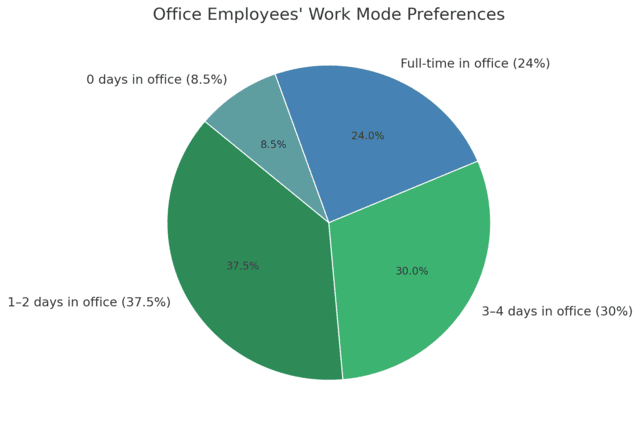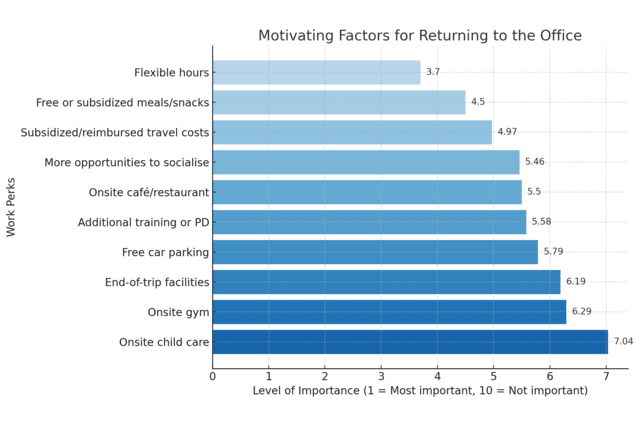Return to Office Trends: Survey of What Employees Really Think
The gradual rollback of remote work arrangements, which were put in place as a short-term fix to keep businesses operating during the height of pandemic lockdowns, has now given rise to one of the most contentious issues in the employment arena. To return to the office, or not to return, that is the question.
Some prominent businesses like Spotify are steadfastly upholding flexible work-from-home policies, stating resoundingly that “remote staff aren’t children.” Other tech giants, however, such as Amazon and iPhone challenger, Nothing, have made U-turns on their previous work-from-home policies, implementing return-to-office policies across the board for all corporate employees.
Taking their lead from the tech heavyweights, return-to-office (RTO) mandates are now widespread for businesses throughout the United States. And with the new administration declaring an RTO mandate for all federal employees of government offices throughout the country, the tide well and truly seems to be shifting against remote, hybrid, and even flexible work schedules.
Contents
- 1 Drastic Shift: From Widespread Remote Work to Full RTOs
- 2 Involving Employees in the Conversation
- 3 Survey of Office Workers on Return-to-Office Mandates
- 4 Employees’ General RTO Perception
- 5 Comparing Productivity Differences Between Remote and In-Office
- 6 Office Workers’ Opinions on Flexible Working Hours
- 7 Other Motivators for Returning to the Office
- 8 Supportive Work Environments and Mental Health
- 9 The Daily Commute Factor
- 10 RTO: Strategic Recommendations for Businesses
- 11 Conclusion
Drastic Shift: From Widespread Remote Work to Full RTOs
The prestige and dominant market power of big-name tech brands helps ensure they can continue to attract top talent in droves, regardless of any contentious mandates like a full RTO. This will remain true even despite the attrition of former remote hires who were attracted by the flexible work location policies of a few short years ago.
The talent that big tech is likely to lose enacting an RTO, due to remote workers being hired out-of-state, their family commitments, or because of inhibitively long commutes, will be quickly replaced by inner-city talent. Or by those willing to travel long distances every day for the CV boost and career acceleration.
Regular businesses don’t have the same luxury of vast workforces to instantly fill gaps, or talent pools of hundreds of thousands clamoring for just an interview. So, SMBs will likely have to work with their employees to find some common return-to-office ground. Or offer better incentives if they want to enact a full RTO.
Understanding the current mindsets and preferences of office workers and managers on the ground (or in their home offices) is going to be crucial for successfully enacting an RTO. Setting out effective in-office strategies and ensuring positive cultural dynamics will be beneficial for both employees and employers.
Involving Employees in the Conversation
For regular businesses, their return-to-office considerations shouldn’t only be around any projected bumps to bottom lines or work culture. Or just about taking their lead from the tech giants, who have vastly different operational parameters.
Since the pandemic ushered in the ‘New World of Work,’ motivations, aspirations and what people deem important have changed. Mandating an RTO won’t simply turn back the clock to pre-2020 times and the ‘golden years’ of buzzing offices that the big corporates are trying to recreate.
It’s not going to be as easy as that. For businesses to effectively pull off a full RTO, it will require redefining what the office experience means for a changed, modern workforce. Further, the climate needs to be shifted away from the doomsaying RTO headlines, instead creating a positive narrative and real, enticing workplace changes on-site. Changes that will benefit both the business and employees.
Survey of Office Workers on Return-to-Office Mandates
To get a better idea of where employees actually stand on this issue, whether they currently work on-site, hybrid, or fully remote, we at Offices.net conducted a comprehensive survey of U.S. office workers aged 25 to 65, exploring their preferences as they currently stand, and their perceptions regarding the widespread return to the office.
Our survey, which was restricted to participants who’d previously transitioned to remote work due to the pandemic, offers valuable insights for businesses that are currently looking at ways to entice their workers back to the office.
Employees’ General RTO Perception
The transition back to the office, as expected, has been met with mixed feelings. 56% of our survey’s respondents stated that they have returned to the office full-time at their employer’s request, while 40.5% of workers are hybrid, and only 3.5% are fully remote. These figures align with the demonstrated push towards “business as usual” from companies and a resumption of traditional work settings.
When asked about their preferred number of days in the office, though, responses varied.
Less than a quarter of respondents were happy with the resumption of the traditional 5 days in-office, highlighting a clear desire for flexibility from employees.

When it comes to office employee preferences around work modes, here are the standout insights from our survey:
– 37.5% of workers prefer working 1–2 days in the office.
– 30% favor a balanced approach with 3–4 days in the office.
– 24% of office workers are comfortable working in the office full-time, five days a week.
– 8.5% would prefer not to work in the office at all.
Comparing Productivity Differences Between Remote and In-Office
Productivity between those who work remotely and in the office doesn’t seem to vary greatly according to our survey respondents, with 39.5% feeling more productive in the office and 35% finding themselves more productive at home. The remainder, 25.5%, of office workers stated their productivity did not alter regardless of location.
This near-even split in work location productivity suggests that the optimal work environment for employees may be personal, and instead only vary across different roles and industries.
Office Workers’ Opinions on Flexible Working Hours
One major advantage of the global shift to remote work was improved work-life balance, as employees saved time usually spent on morning preparations and long commutes. That drastic change from the traditional 9-to-5, with anywhere from 30 minutes to over an hour commuting each way morning and night, allowed more opportunities for personal pursuits and family time. People have understandably become accustomed to this and are loath to give it up.
Another important—though probably unsurprising—finding from the survey is the high value that employees currently place on flexible working hours.

We asked respondents to rate some workplace perks, such as free parking, onsite gyms, and more socializing opportunities, with scores of 1 (most important) to 10 (not important). With a mean score of 3.7 across all office-working survey respondents, flexible hours emerged above all other perks as the most critical factor influencing their willingness to return to the office.
This clear preference highlights employees’ continued focus on their work-life balance, and the pressing need for businesses to adapt to these changed worker expectations.
Other Motivators for Returning to the Office
Beyond flexibility, several other amenities and incentives were highlighted as significant motivators for returning to the office:
– Free or subsidized meals and snacks was the next most popular perk after flexible hours, scoring a mean rank of 4.5 out of 10 from our survey respondents and reflecting the appeal of cost-saving benefits and convenience.
– Social opportunities with coworkers and onsite cafés or restaurants also ranked highly in desirability, indicating that social interaction and community aspects are crucial for a pleasant in-office experience.
However, amenities like onsite child care and end-of-trip facilities (e.g., bike storage, personal lockers, and showers) are seen as less critical motivators for office attendance, only scoring 7 and 6 out of 10, respectively, in terms of their priorities. This result came as a bit of a surprise, since many leading employers offer these perks as standard and often promote them heavily. These work perks are also still commonly seen in full-suite employee benefits packages across many industries.
Supportive Work Environments and Mental Health
Supportive work environments are essential for employee satisfaction and positive mental health. A great sign for the current state of workplace support, our survey revealed that 72% of office workers felt their company was supportive of flexible working arrangements.
Also, encouragingly, 46.5% reported a positive impact on their mental health since returning to the office. This suggests that, for many, the office environment provides a structured and beneficial setting that may enhance employee well-being.

The Daily Commute Factor
Commuting remains a big consideration for the modern office worker, with 51% of survey respondents commuting 15–30 minutes to and from work every day.
The hip pocket costs associated with commuting are also significant, with over 40% of survey respondents spending up to 10% of their daily income on commute-related expenses.
With the widespread cost-of-living pressures, employers might consider how to alleviate these financial and time burdens, possibly through commuting benefits, carpool incentives, or more flexible work locations like coworking centers.
RTO: Strategic Recommendations for Businesses
Based on the major findings from our survey, Offices.net recommends the following strategies for businesses looking to effectively entice workers back to the office:
- Emphasize Flexibility: Businesses should look at implementing hybrid work models or, at least, flexible working hours, so employees can start and finish work earlier or later to more easily fit work around their life commitments. From our survey, it’s very evident that employees want some input into when and how often they work from the office.
- Improve Office Amenities: Only 24% of workers are currently happy with working in the office full-time, so to keep these employees happy and to get the majority on board with an RTO, ongoing incentives and perks should be provided. Focus on amenities that add value and convenience, such as free meals, parking or travel allowances, improved social spaces, and wellness programs.
- Support Commuting Needs: With almost 40% of office workers spending up to 10% of their take-home pay just on commuting costs, business leaders can play a part in alleviating some of this burden. This can be done practically by offering travel benefits, commute reimbursements, or more flexible options for work location.
- Create a Supportive Office Environment: A great sign from our survey was that 46.5% of office workers felt their mental health improved when returning to the office. And with 72% of office workers currently feeling well-supported by their employer’s flexible work policies, it’s important to keep this clear majority happy. And to get as close to 100% as possible.
It’s clear that businesses should continue to support flexible working arrangements and ensure their office environments promote both well-being and productivity.

Conclusion
The widespread shift to remote working—and now moving to more workplace flexibility—represents a fundamental shift from the traditional perspective on work and productivity.
The physical office space will undoubtedly continue to play a crucial role in the future, especially as more and more businesses push for a return to the office. But the role has needed to evolve from simply a place where work gets done, to one that supports employees’ lives in general.
Companies that understand and adjust to the shifts in employee expectations will be in a better position to draw in and keep top talent, maintaining their competitive advantage in a world that is changing quickly.
More Insights
Interested in learning about other ways to entice your employees and new talent back to the office? Or would you like to know more about trends in the U.S. business world and the kinds of office space and office buildings they occupy? See the links below for more of our recent stories on these and other subjects.
Best Cities to Start a Business in the USA
New York Central Business District
United States Commercial Property Prices Per Square Foot in 2024
Top Ten Largest CBDs in the USA
The Cost of Renting Office Space in Boston
Analyzing the Cost of Office Space in Washington DC
Commercial Real Estate Depreciation – How Does It Work?
NYC Office Space Rental: A Cost Analysis
Cost of Office Space in San Francisco vs LA Office Rental Prices
Mixed-Use Commercial Property: What You Need to Know
